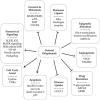Natural Polyphenols for Prevention and Treatment of Cancer
- PMID: 27556486
- PMCID: PMC4997428
- DOI: 10.3390/nu8080515
Natural Polyphenols for Prevention and Treatment of Cancer
Abstract
There is much epidemiological evidence that a diet rich in fruits and vegetables could lower the risk of certain cancers. The effect has been attributed, in part, to natural polyphenols. Besides, numerous studies have demonstrated that natural polyphenols could be used for the prevention and treatment of cancer. Potential mechanisms included antioxidant, anti-inflammation as well as the modulation of multiple molecular events involved in carcinogenesis. The current review summarized the anticancer efficacy of major polyphenol classes (flavonoids, phenolic acids, lignans and stilbenes) and discussed the potential mechanisms of action, which were based on epidemiological, in vitro, in vivo and clinical studies within the past five years.
Keywords: anti-inflammation; anticancer; antioxidant; flavonoid; polyphenol.
Figures











References
-
- WHO|Cancer. [(accessed on 17 May 2016)]. Available online: http://www.who.int/mediacentre/factsheets/fs297/en/
-
- Manach C., Scalbert A., Morand C., Remesy C., Jimenez L. Polyphenols: Food sources and bioavailability. Am. J. Clin. Nutr. 2004;79:727–747. - PubMed
-
- Deng G.F., Lin X., Xu X.R., Gao L., Xie J., Li H.B. Antioxidant capacities and total phenolic contents of 56 vegetables. J. Funct. Foods. 2013;5:260–266. doi: 10.1016/j.jff.2012.10.015. - DOI
Publication types
MeSH terms
Substances
LinkOut - more resources
Full Text Sources
Other Literature Sources
Molecular Biology Databases
Miscellaneous

